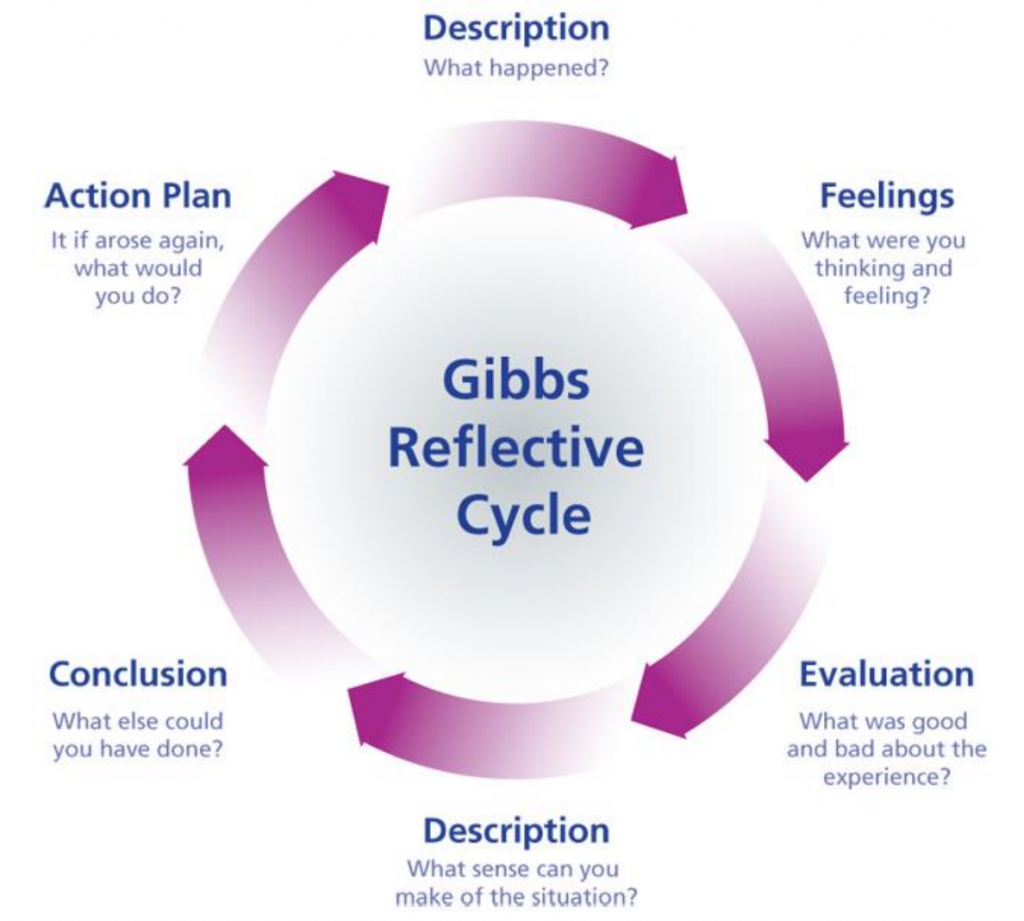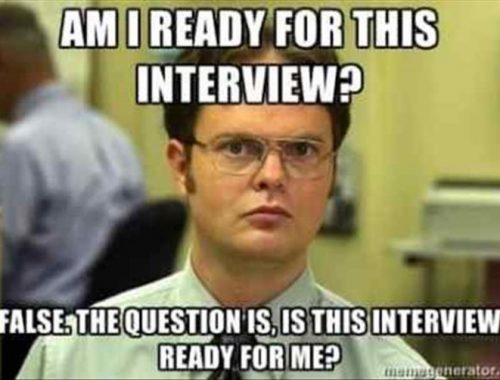Trying to escape the 67%…

‘67% of employers suggest recent graduates need to improve their interview performance’
(Chronicle of Higher Education, 2013)

It is certainly a scary statistic, and one that makes the uphill battle of finding a graduate job an even steeper climb. But all hope is not lost yet… the chance to have a trial run in front of peers instead of a pursed lipped, poised panel gave me an opportunity to better understand the perspective of both sides of the interview process. I decided to use the same model of reflection as I had previously to ensure continuity and, as it is used by my preferred employer, it presents an opportunity to practise in the module something I may later rely on professionally. This blog hopes to utilise the Gibb’s reflective process to break down the lessons learnt; skills gained and introduce the sweet power of hindsight onto the dreaded interview process.
Description
What happened?
The process required us to begin by finding a job description similar to one we are looking at for future applications. I chose an NHS role as an Operational Support Manager, my outlook being that this job, and ones of a very similar framework, are those I have applied for. Therefore, aside from allowing me to practise my overarching interview technique, I was able to use the module as a practise run to reach my future career goals. We then were asked to share these descriptions amongst our group and write several questions for our peers. Then, judgement day came, and we sat down as a group and interviewed each other in turn.
Feelings
What were you thinking and feeling?
With an experience as innately stressful as an interview, more so a public one judged by your friends, it was a difficult task to decipher any other feelings as they were all shrouded in panic!
Stress seems synonymous with interviews as if they are mutualistic: you cannot have one without the other. It made all other emotions feel heightened and is scientifically proven to cloud your judgement. Despite the fact this is when you require the most clarity.
My stress induced self, frantically rereading the job description could only get me so far. I had watched a talk endorsing the premortem: where ‘you look ahead, and you try to figure out all the things that could go wrong’ (Levitin). Anticipation set in here, I went to prepare my outfit; my route to avoid traffic and what I would eat for breakfast, all in the aim of reducing my stress levels.
It was during this preparation when I realised I also felt an immense pressure. If I was to embarrass myself, I could not adopt my normal approach of ‘don’t worry I never have to see them again’. As my course mates were the panel, they were very literally unavoidable, this only compounding my anxiety.
Evaluation
What was good and bad about the experience?
As Burkeman emphasises in his article, ‘hindsight is even more transformative than you think’ (2014) and Gibbs’ model centralises it in the cycle of ‘appreciation, action and reappreciation’ (Schön, 2016:131).
The experience was non job specific, so naturally my classmates couldn’t ask the questions that an industry expert might. This meant that I found myself subconsciously playing to what I thought they would expect to hear about healthcare, rather than prioritising my knowledge of specific hospital values and strategy. Although the peer feedback showed that they were satisfied with my responses, I realised that I had missed a valuable opportunity to practise accurate terminology and distinctive examples.
However, this was a great way to demonstrate agile thinking; adapting to a new environment and hone interpersonal skills, all of which were featured on my original job description. By utilising controlled and non-threatening body language: keeping myself from fidgeting and trying to employ a smile as much as possible (without alarming the panel). Research, and experience, alluded to the disarming negotiating power a smile can possess as ‘your smile is a messenger of your good will’ (Carnegie, 76). In the past, working in a hospital environment where staff and patients alike face inordinate stress and pressure, smiling helps alleviate tension and inspire morale. This Forbes article detailed this as an attraction to employers as ‘smiling shows amicability, and that’s a huge necessity in the workplace’ (Farrington, 2014).
Description2
What sense can you make of the situation?
As the reflective process reached ‘reappreciation’ (Schön, 2016:131) I was able to evaluate other, external influencing factors. Having a structured written feedback form also contributed to the value added by the task. Whilst providing a medium to take away feedback, and be able to quote it in this assignment, it offered a chance to be frank and truthful. This was a vital takeaway, as discussing ‘lessons learnt’ as a team is integral to any workplace – as the video below establishes. Yet, as the panel was composed of peers, all of the same age, on the same course and often our friends, it can make the process of subjective feedback challenging. No-one wanted to affect anyone’s confidence or cause any upset, and even by being constructive it is an uncomfortable situation to criticise your ‘equal’. The written medium allowed for better and clearer expression, without the worry of offending a friend.
Conclusion
What else could you have done?
Even though I did have the opportunity to ask questions at the end of my turn, I do not feel I spent as long as I could have preparing them. I think it was easy to misjudge how important their importance and only through interviewing others did it highlight to me how impactful a well thought out question can be. The Forbes article complied by employers’ advice drew great attention to this, with one stating ‘candidates who truly interviewed me and the company were at the top of my list’ (Farrington, 2014).

The STAR model we were introduced to by our career’s consultant Emma, allowed for a detailed breakdown in approaching where exactly improvements needed to be made. My peer feedback centred around improving results driven answers. I spent too long dwelling on the description and action but not enough quantifying results, which is something employers said they looked for: ‘individuals who can pick out a few successes that correlate to the position they’re looking to land […] discuss what the problem was, the solutions and results achieved.’ (Farrington, 2014).
Action Plan
If it arose again, what would you do?
Considering all the external advice; the feedback of my peers and my own reflection, next time I would take the time to write interview questions for the job and not simply prepare for questions I had found trawling google… I would then produce several case studies that could be applied to different scenarios, and, whilst maintaining the STAR structure prioritise results backed by figures. I would also give the hiring team a professional ‘stalk’, using this as a springboard to prepare for my own questions. Lastly, I would take my positive feedback and remain confident that I can do it… As Dale Carnegie said, ‘Thought is supreme. Preserve a right mental attitude’ (Carnegie, 75)
Bibliography
Azzopardi, D L. “Interview Techniques – STAR Method”. LinkedIn. [Online]. Retrieved from: https://www.linkedin.com/pulse/interview-techniques-star-dayna-l. Date Accessed 12.03.2023.
Bingham, C. (2016). Employment Relations: Fairness and Trust in the Workplace. London: Sage Publications, pp
Burkeman, Oliver. (2014). This column will change your life: hindsight – it’s not just for past events, The Guardian. [Online]. Retrieved from: https://www.theguardian.com/lifeandstyle/2014/may/10/hindsight-in-advance-premortem-this-column-change-life
Carnegie, D. (2006). How to Win Friends and Influence People. UK: Vermillion, pp 69-77.
Chronicle of Higher Education and Marketplace (2013). Survey of employers who hire recent college graduated with bachelor’s degrees. [Online]. Retrieved from: http://chronicle.com/items/biz/pdf/Employers%20Survey%20-Annotated%20Instrument.pdf. Date accessed 12.02.2023.
Farrington, Robert. (2014). 15 Career Experts Share the Best Interview Tips for College Graduates, Forbes. [Online]. Retrieved from: https://www.forbes.com/sites/robertfarrington/2014/07/07/15-career-experts-share-the-best-interview-tips-for-college-graduates/?sh=7b98c07b2756
Gibbs, G. (1998). Learning by Doing: A Guide to Teaching and Learning Methods. Oxford: Oxford Unit.
Levitin, Daniel (2015). How to stay calm when you know you’ll be stressed, online video, TED, YouTube. [Online]. Retrieved from: https://www.youtube.com/watch?v=8jPQjjsBbIc&list=PLOGi5-fAu8bHaEGV52hSzl8QeUM4933Xy
NMC Videos (2016) Revalidation: Reflective Discussion. [Online]. Retrieved from: https://www.youtube.com/watch?v=fJUp8-V8_xE. Date Accessed 12.02.2023.
‘Operational Management’. NHS. [Online]. Retrieved from: https://www.healthcareers.nhs.uk/explore-roles/management/roles-management/operational-management. Date accessed 13.02.2023.
“Reflective discussion”. The Nursing and Midwifery Council, (2021). [Online]. Retrieved from: https://www.nmc.org.uk/revalidation/requirements/reflective-discussion/ . Date accessed 12.02.2023.
Schön, D A. (1995). The Reflective Practitioner: How Professionals Think in Action. England: Ashgate, pp 140.
The “Nervous” Cliché
You May Also Like

Challenge Accepted Sir!
18 April 2023
“Fake it ‘til you make it!”: Finding Success in a Simulated Interview
22 February 2023
